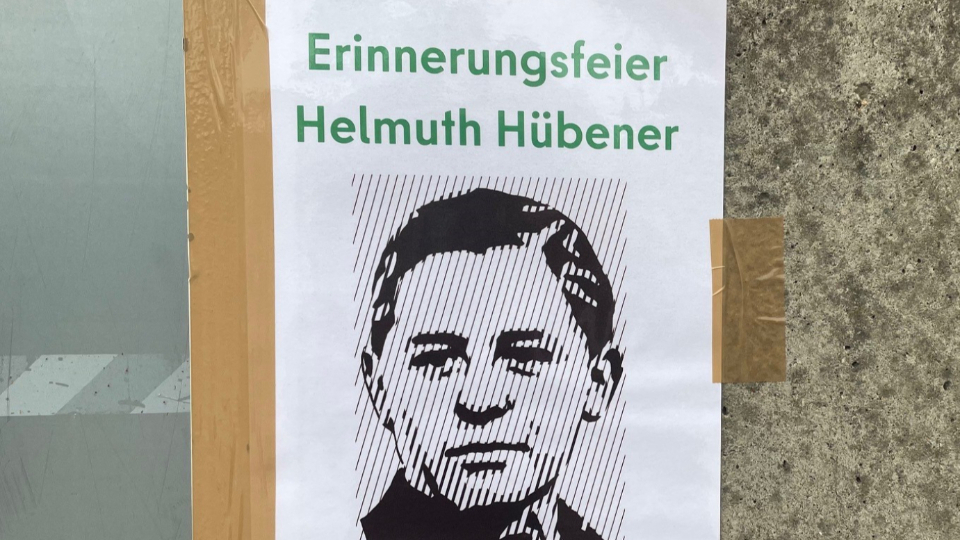The Helmuth Hübener School in Berlin recognised the 81st anniversary of Helmuth Hübener's tragic passing with a memorial celebration on Friday, October 27, 2023. As part of the event, the exhibition “Paths of Remembrance” was unveiled and a graphic novel about Helmuth Hübener, created in cooperation with the Anne Frank Center, was presented.

Gedenkfeier-Helmuth-Hubener
Poster at the gate of the Berlin Youth Detention Centre.2023 by Intellectual Reserve, Inc. All Rights Reserved.Born in Hamburg, Helmuth Hübener was the youngest resistance fighter against National Socialism to be sentenced to death by the People’s Court and executed. On October 27, 1942, at the age of 17, his life was taken by guillotine in the Berlin-Plötzensee prison. Until his violent death, he was a member of The Church of Jesus Christ of Latter-day Saints and drew strength and guidance from his faith.
The Berlin Senator for Justice and Consumer Protection Dr. Felor Badenberg emphasised the fearlessness of the honoree. “The 1942 sham trial failed to impress Helmuth Hübener,” she explained. Even in the courtroom, he asked uncomfortable questions and raised his voice against injustice. He took sole responsibility and thus saved his colleagues from even worse consequences. At the Senator's request, the audience rose from their seats for a moment of quiet remembrance.
The Helmuth Hübener School is part of the Berlin Youth Detention Centre. The young men housed there are as much a part of Berlin as all the city's young people, noted Bill Borchert, director of the facility. They are very interested in political themes and connections, he said. “In many ways, Helmuth Hübener’s life and commitment to his convictions are present in the everyday life of this institution,” he added, looking back at the naming of the school in 2020.
The Helmuth Hübener School wants to convey the importance of one's own free will, added Birgit Lang, head of school. Young people should learn to use their own judgment. That's exactly why efforts are being made to make history lessons exciting, incorporating art and dialogue, Lang explained.
A staged reading by detained youth, who had co-authored the texts based on original quotations, gave rise to a lengthy standing ovation. Some in the audience had tears in their eyes. The young people on stage reported on the lives of Helmuth Hübener, Walter Klingenbeck and Günther Discher. Klingenbeck was a young resistance fighter and Discher's love of swing music landed him in a concentration camp.
An actor playing Helmuth Hübener performed a rap that included the following lines: “Hübener, my name, my faith is my anchor. It sets the direction, my daily motto, 'be grateful.' I'm a Mormon, but am I hiding? I don't get what the Nazis believe." He also quoted on stage from a letter that Helmuth had written to a family friend on the day of his execution: "My Father in Heaven knows that I have done nothing wrong […] I know that God lives, and He will be the just judge of this matter.”
The new graphic novel about Hübener is another link in a chain of publications that have given him reason to hope, said Professor Dr. Alan Keele who had traveled from the United States to attend. He referred to the publications of journalist Ulrich Sander and to the novel “Örtlich Betäubt” by Günter Grass. He also mentioned that the publisher Erwin Roth, who traveled to the event from Salzburg, is preparing a new edition of Keele’s book and that filmmaker Matt Whitaker is producing a dramatic series called “Truth & Conviction,” based on the story of Helmuth Hübener. Filming is set to begin in April 2024 in Lithuania.
“Everyone can ensure that their life is not mindlessly wasted,” said the German studies scholar who taught at Brigham Young University in the U.S. State of Utah, before retiring. If everyone in their own environment – inspired by Helmuth Hübener – worked to turn things around for the better, a multiplier effect would arise. A leaflet written by Helmuth carried the appeal, “This is a chain letter and therefore pass it on.” The commitment to truth and justice is meant to be shared and emulated.
“We can learn from his courage and resilience today,” confirmed Dr. Katinka Meyer, education officer at the Berlin Anne Frank Centre. She encouraged those present to work against exclusion and discrimination and to promote a climate of openness. The Anne Frank Center was involved in the creation of the graphic novel.
Detained young people from the Berlin Youth Detention Centre and the Plötzensee Correctional Facility took part in the creation of the exhibition “Paths of Remembrance.” It traces the fate of prisoners at the Plötzensee prison during National Socialism.
In his speech, Professor Dr. Johannes Tuchel, head of the German Resistance Memorial Centre, recalled the events of September 1943. On September 3, Berlin experienced one of the first major air raids when 200,000 fire bombs fell on the city. The prison inmates remained in their cells and were only taken below when the roof of one of the buildings caught fire. After that, 250 prisoners were hanged within a few days – the largest Nazi murder operation in Berlin. At that time, a corrupt state abused the courts to accomplish their ends, Professor Tuchel concluded.
Among the guests at the event were several members of The Church of Jesus Christ of Latter-day Saints, including representatives from the Church’s European Communication Department, German Federal Communication Council and local Berlin Church congregations.
Last year – 80 years after Helmuth Hübener's execution – The Church of Jesus Christ of Latter-day Saints held a memorial service in Berlin. Hübener's actions were unusual as most members of the Church tried to stay away from politics during the Nazi regime, though some succumbed to the fascination of state propaganda. The Hamburg teenager Helmuth Hübener put up resistance.